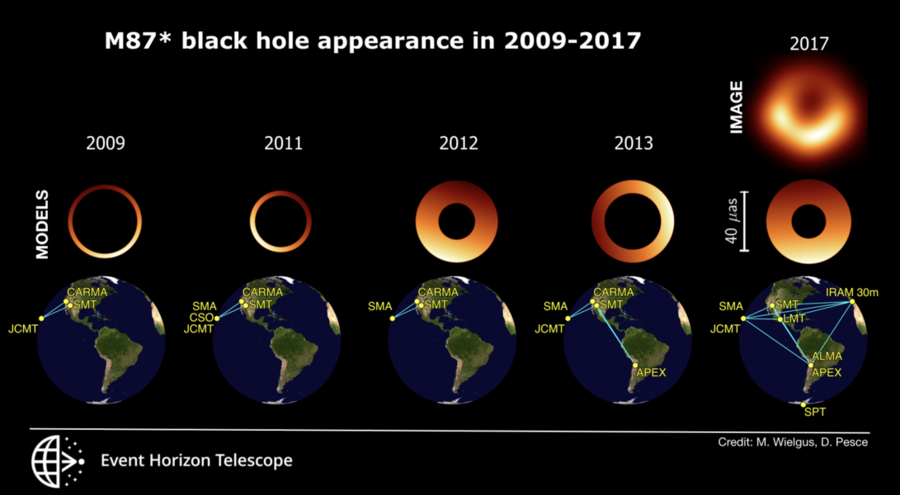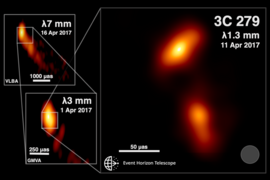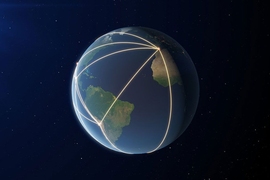In 2019, the Event Horizon Telescope (EHT) Collaboration, including a team of MIT Haystack Observatory scientists, delivered the first image of a black hole, revealing M87* — the supermassive object in the center of the M87 galaxy. The EHT team has used the lessons learned last year to analyze the archival data sets from 2009 to 2013, some of which were not published before. The analysis reveals the behavior of the black hole image across multiple years, indicating persistence of the crescent-like shadow feature, but also variation of its orientation — the crescent appears to be wobbling. The full results appear today in The Astrophysical Journal in an article titled, “Monitoring the Morphology of M87* in 2009–2017 with the Event Horizon Telescope.”
The EHT is a global array of telescopes, performing synchronized observations using the technique of very long baseline interferometry. Together they form a virtual Earth-sized radio dish, providing a uniquely high image resolution. In 2009–13, M87* was observed by early-EHT prototype arrays, with telescopes located at three geographical sites from 2009 to 2012 and four sites in 2013. In 2017, the EHT reached maturity with telescopes located at five distinct geographical sites across the globe.
Datasets for this research were fully correlated at MIT Haystack Observatory. The 2009–2013 observations consist of less data than the ones performed in 2017, making it impossible to create an image. But the EHT team was able to use statistical modeling to look at changes in the appearance of M87* over time. In the modeling approach, the data are compared to a family of geometric templates, in this case rings of non-uniform brightness. A statistical framework is then employed to determine if the data are consistent with such models and to find the best-fitting model parameters.
“This is a beautiful example of creative data analysis. Extracting important new astrophysical understanding and squeezing new insight out of previous observations is an imaginative example of how scientists can maximally use the information content of such painstakingly collected data,” says Colin Lonsdale, director of MIT Haystack Observatory and chair of the EHT Collaboration Board. “The behavior of this event horizon scale structure over a period of years allows important additional constraints to be placed on the properties of this fascinating object.”
Expanding the analysis to the 2009–2017 observations, EHT scientists have shown that M87* adheres to theoretical expectations. The black hole’s shadow diameter has remained consistent with the prediction of Einstein’s theory of general relativity for a black hole of 6.5 billion solar masses.
“In this study, we show that the general morphology, or presence of an asymmetric ring, most likely persists on timescales of several years,” says Kazu Akiyama, research scientist at MIT Haystack Observatory and a participant in the project. “The consistency throughout multiple observational epochs gives us more confidence than ever about the nature of M87* and the origin of the shadow.”
Although the crescent diameter remained consistent, the EHT team found that the data were hiding a surprise: The ring is wobbling, and that means big news for scientists. For the first time, they can get a glimpse of the dynamical structure of the accretion flow so close to the black hole’s event horizon, in extreme gravity conditions. Studying this region holds the key to understanding phenomena such as relativistic jet launching, and will allow scientists to formulate new tests of the theory of general relativity.
The gas falling onto a black hole heats up to billions of degrees, ionizes, and becomes turbulent in the presence of magnetic fields. “Because the flow of matter is turbulent, the crescent appears to wobble with time,” says Maciek Wielgus of the Harvard and Smithsonian Center for Astrophysics, who is a Black Hole Initiative fellow, and lead author of the paper. “Actually, we see quite a lot of variation there, and not all theoretical models of accretion allow for so much wobbling. What it means is that we can start ruling out some of the models based on the observed source dynamics.”
“MIT Haystack Observatory was instrumental in organizing these early observations, correlating the massive amounts of data returned on large numbers of hard drives, and reducing the data,” says Vincent Fish, research scientist at Haystack Observatory. “While we were able to place important constraints on the size and nature of the emission in M87* at the time, the images made from the much better 2017 array data provided critical context for fully understanding what the earlier data were trying to tell us.”
Haystack scientist Geoff Crew adds, “After working on EHT technology for a decade, I’m gratified that M87* has been making equally good use of its time.”









